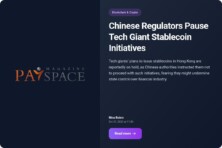The People’s Bank of China has tightened its control over interest rates, deciding to introduce a new mechanism to influence the cost of short-term borrowing.

The mentioned decision is an action in the context of the broader desire of the Asian country’s financial regulator to expand the tools through which the market guide process is carried out.
The central bank of China has started conducting new bond repurchase or reverse repo operations. The corresponding actions of the financial regulator of the Asian country reduce the range within which short-term interest rates may fluctuate. It is expected that these decisions of the People’s Bank of China will strengthen and reinforce market expectations that the seven-day repurchase rate will move into the category of a new benchmark. The probability of realizing the mentioned assumption is maximum.
The governor of the People’s Bank of China, Pan Gongsheng, took measures in the current year aimed at strengthening control over market liquidity. Also, the relevant actions have extended to monitoring the cost of borrowing along the entire yield curve. Currently, the financial regulator of the Asian country prefers a single short-term rate. Also, in the summer, officials of the People’s Bank of China announced their intention to cool the rise in bond prices as part of the sale of long-term securities, which demonstrated the dynamic of the growth against the background of increasing demand for so-called haven assets. The corresponding demand was formed against the background of the protracted crisis in the Chinese real estate sector and excessive economic uncertainty.
Duncan Wrigley, chief China economist at Pantheon Macroeconomics, says that the current decisions of the Asian country’s financial regulator will give it more control over short-term rates and create greater flexibility for managing liquidity fluctuations. The expert said that the People’s Bank of China now has new management tools that will be needed if the sale of bonds provokes an excessive crunch in short-term liquidity. The relevant instruments can be described as a means of preventing a liquidity crisis.
The latest policy decision by the People’s Bank of China raised the yield on 10-year bonds to the highest level since May on Monday, July 8.
Currently, economic officials in the Asian country are making efforts aimed at balancing economic growth, which is on a trajectory of increasing intensity, and maintaining the stability of the yuan against the background of high interest rates overseas and the ongoing crisis in the local real estate sector, which is a factor of negative impact on demand in China.
Beijing is also nowadays facing a significant deterioration in the condition of trade relations with Washington and European capitals. Against the background of this state of affairs, the probability of positive prospects for the manufacturing industry of the Asian country, which has been showing growth indicators since the beginning of the current year, is weakening.
The People’s Bank of China will conduct bond repurchase operations from 4 p.m. to 4:20 p.m. on weekdays as needed. It’s worth noting that these actions will be an addition to the traditional morning operations. The relevant information is contained in the official statement of the financial regulator of the Asian country, which was published on Monday. The validity period of the ad hoc repo and reverse repo will be overnight. The rates will be set at 20 basis points lower and 50 basis points higher than the seven-day reverse repo rate, respectively. The statement of the financial regulator of the Asian country notes that these actions are aimed at ensuring reasonable and sufficient liquidity in the banking system. Also, in the context of the relevant decision of the People’s Bank of China, the goal is to increase the precision and effectiveness of operations on the open market.
The Asian country’s financial regulator did not announce any additional market operations on Monday afternoon.
Becky Liu, head of China macro strategy at Standard Chartered, says that against the background of the specified decisions, the interest rate corridor in the Asian country will narrow from about 230 basis points previously to 70 basis points now. According to the expert, the volatility of interbank rates will decrease against the mentioned background. Becky Liu noted that with lower volatility, the seven-day reverse repo rate will be more widely used as the benchmark reference rate for most assets and liabilities, including deposit and loan rates.
Measures aimed at improving the technical tools available for use by the People’s Bank of China may give the Asian country’s financial regulator more flexibility. At the same time, in this case, there is no guarantee that the mentioned actions will become a means of improving the situation formed in the context of the challenges that Beijing is currently facing in the economic space. Nowadays, in China, companies and households adhere to a behavior strategy that provides for maximum rejection of additional debts. Against the background of this specificity of modernity, which has been formed in an Asian country, it seems doubtful that credits will be able to prop up the economic system. Also, at present, the Chinese financial authorities probably do not have an understanding of how to ease the cost of the population and businesses on borrows, avoiding the implementation of a scenario of a weakening of the yuan.
The statement released on Monday was a kind of declaration of the People’s Bank of China’s next move after this regulator reported a few days ago that it had prepared for the borrowing of medium- and long-term bonds worth hundreds of billions of yuan. An opinion is currently spreading among experts, according to which officials of the central bank of the Asian country are contemplating the possibility of selling securities to stop the negative tendency of falling long-term bond yields.
In the current year, Chinese government bonds are on a growth trajectory. The corresponding tendency is associated with the not-very-optimistic prospects for the further dynamic of the economy of the Asian country and expectations of cutting interest rates. The lack of full-fledged alternatives and the switch from savings to financial investments have become a kind of base for the growth of demand for the mentioned bonds. Against the background of the relevant state of affairs, the People’s Bank of China has repeatedly stated the risk of a bound bubble. The financial regulator separately notes that this potential negative scenario is especially relevant for longer-dated debt.
The new corridor around the seven-day reverse repo rate may be evidence of the need to tighten controls at the other end of the yield curve as well.
Analysts Stephen Chiu and Jason Lee say that China may essentially adopt regulating the yield curve, as the Asian country’s financial regulator intends to control the longer end of the curve through treasury bond trading. In their opinion, in the future, cutting rates can be carried out primarily through a seven-day reverse repo.
The actions of the People’s Bank of China may indicate the move away from one of the headline instruments of the Asian country’s financial regulator in the past, which are policy loans for one year, also known as a medium-term lending facility (MLF). Since its introduction ten years ago, the mentioned mechanism has become the major channel for the central bank of China to inject money into the economy and guide market rates. In recent months, the dynamic of demand of creditors for appropriate funds has been on a downward trajectory. This state of affairs is because it is cheaper for banks to borrow from each other.
The MLF interest rate has been steady for 10 months. At the same time, the cost of other borrowing in the economy has plunged sharply.
Zhou Hao, chief economist at Guotai Junan International, says that the supply of credit has become very volatile, and sometimes even negative. The expert also said that the new operations are evidence that the People’s Bank of China is striving to maintain a firm corridor of the cost of funds. Zhou Hao says that the mentioned aspiration is aimed at ensuring confidence in the policy of the Asian country’s financial regulator.
Pan Gongsheng said last month during a speech at a forum in Shanghai that the People’s Bank of China would reform interest rate policy. According to him, appropriate decisions and actions are necessary to improve the transmission, including an appropriately narrowed interest rate corridor.
In Shanghai, the governor of the People’s Bank of China also drew attention to the risks associated with the fact that non-bank financial entities hold a large amount of medium- and long-term central government bonds. According to him, the corresponding state of affairs could create a maturity mismatch and interest rate risk.
Pan Gongsheng vowed to maintain an upward-sloping yield curve, mentioning in the appropriate context the collapse of the Silicon Valley Bank in the United States last year. The mentioned financial institution ceased to exist after the Federal Reserve System began implementing a monetary policy strategy in 2022, providing for an increase in interest rates.
The Chinese government has declared its intention to pursue a proactive fiscal policy and prudent monetary policy in the current year. The authorities also pledged to maintain liquidity at the proper level.
It is worth noting that the future of the Chinese economy, despite the many already existing difficulties of nowadays, and all sorts of risks associated with the upcoming months and years, is still not unequivocally assessed by literally all experts as a negative scenario or something like a territory of prospects where there can be no positive expectations. For example, in May the International Monetary Fund revised its forecast for the economic growth of the Asian country in 2024 towards improvement. Experts of this organization expect that the corresponding figure for the current year will increase by 5%. The previous version of the IMF forecast provided that China’s economy would show growth of 4.6% in 2024. It is worth noting that Beijing has set an economic growth target for the current year at 5%. Moreover, in the first quarter of 2024, China’s gross domestic product increased by 5.3%, which exceeded preliminary expectations for the dynamic of this indicator.









